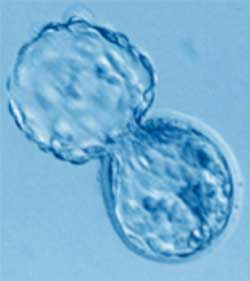Why doesn’t every embryo become a baby?
The enigma of embryo implantation – why doesn’t every embryo become a baby?
While modern technology is very good at making embryos in the laboratory, we still cannot control the implantation process. We do not know which embryo will become a baby – and this can be very frustrating, for both patients and doctors ! Many patients who do not get pregnant after an embryo transfer start believing that their bodies are defective, and that they have "rejected" the embryo. They feel that if they failed to become pregnant even after the doctor transferred 3-4 good quality embryos, that they are flawed. However, you need to remember that embryo implantation is a very complex process, which consists of a series of phases in which the embryo has to appose and attach itself to the maternal endometrium and invade into it.
First, the embryo has to undergo further development, till it reaches the blastocyst stage, when it hatches from its shell, known as the zona.

The hatched blastocyst then needs to implant in the endometrium, and the three phases of implantation are known as apposition, adhesion and invasion, and occur during the period of time known as the implantation window. Apposition, or orientation of the embryo (which is at the blastocyst stage at this time ) within the cavity of the uterus, starts when the cavity has become minimal due to the suction of endometrial fluid by pynopods (small protrusions found on the surface membrane of the cells lining the uterus). Adhesion of the blastocyst is a progressive phenomenon that ties the embryo to the endometrium and is the primary event initiating invasion. Many molecules, such as cytokines, growth factors and cell adhesion proteins called integrins play an important role in this complex process during which the blastocyst and maternal endometrium must undergo an exquisite dialogue. Invasion is a self-controlled proteolytic process that allows the embryonic trophoblast to penetrate deep into the maternal decidua and to invade the endometrial spiral arteries by producing chemicals called proteinases. How implantation is regulated and brought about remains an enigma, but we need to remember that the implantation process is surprisingly inefficient in humans – Nature is not always very competent! After IVF, it’s only about 10%, which means that only 10% of embryos implant successfully to become a baby.
The responsibility for this low efficiency has to be shared between the embryo as well as a defective embryo-endometrium dialogue. We still cannot successfully predict which patient will get pregnant after embryo transfer . We now know that one of the major reasons for failure of the embryo to implant is a genetically abnormal embryo. Basic research on implantation is of great interest today, because embryonic implantation is the major factor limiting in allowing pregnancy after ART, but we still need to learn a lot about this "black hole" in our knowledge, before we can learn to control it !
Many patients blame themselves when they don’t get pregnant after an embryo transfer. They feel that the fact that the embryo did not implant means either that their body is defective; or that it "rejected" the embryo; or that they did not rest enough. However, please do remember that embryo implantation is a complex process, which you cannot influence by your diet or physical activity – so there is no need for you to blame yourself if the embryos do not implant.





1 comment:
Wow, that's fascinating! Your little embies had better get their sticking on!
Post a Comment